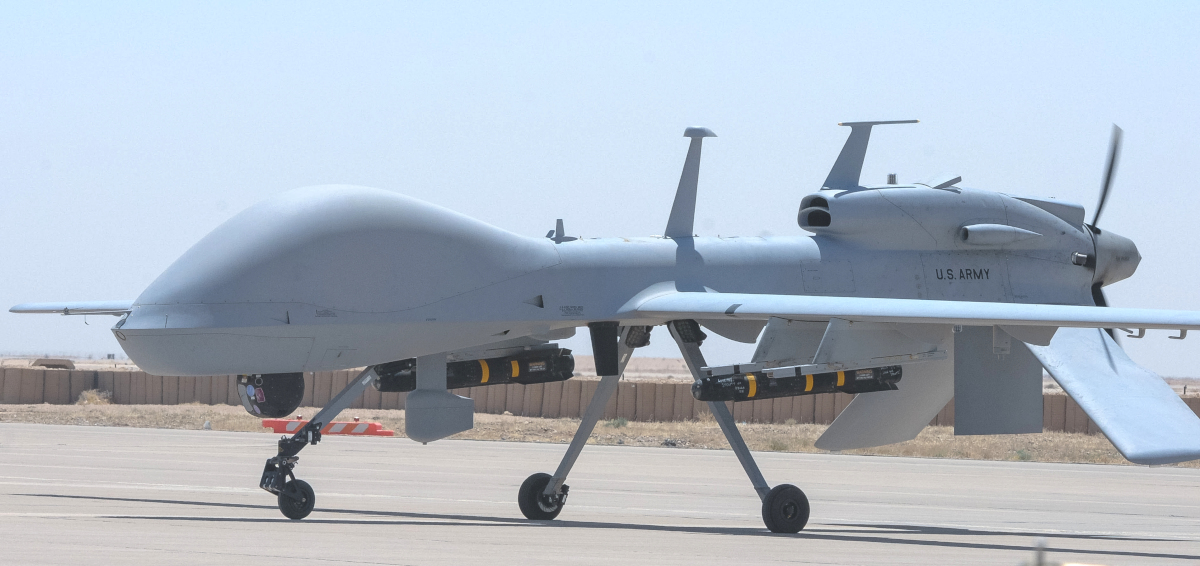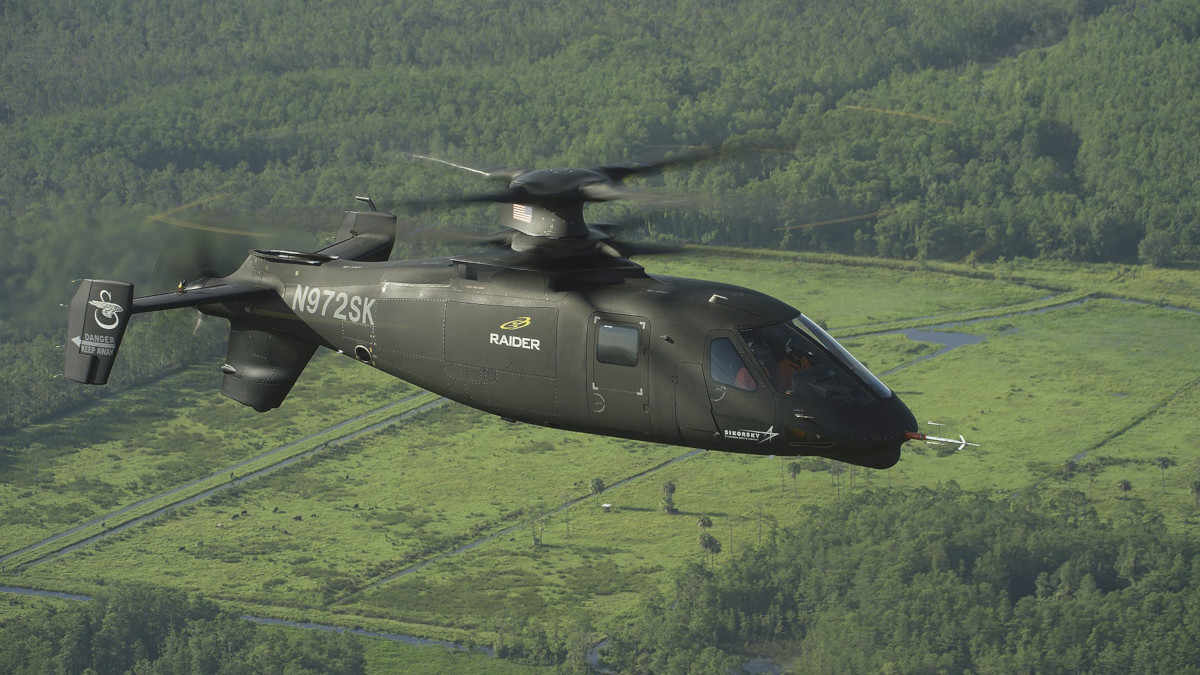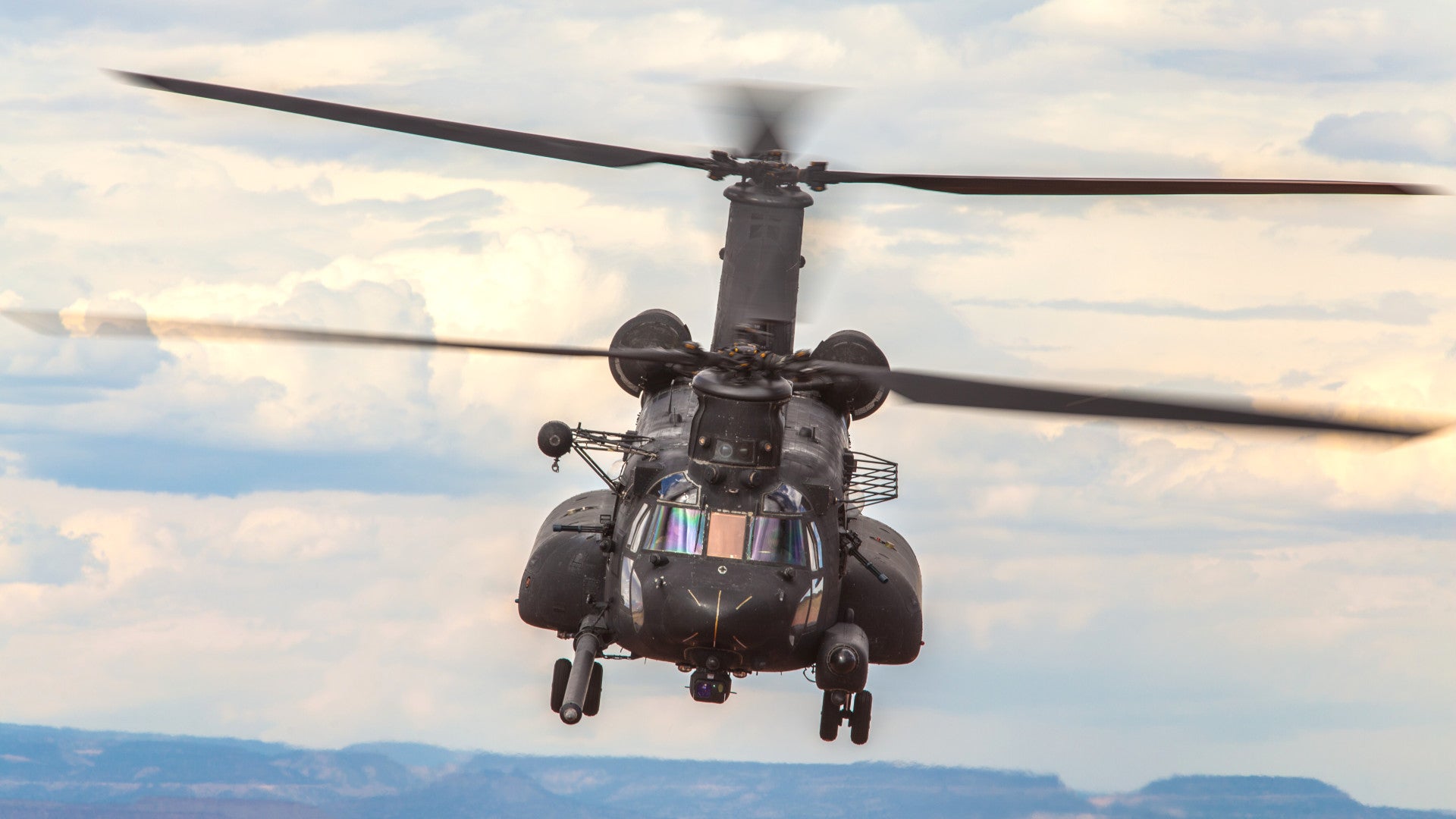Members of the U.S. Army’s elite 160th Special Operations Aviation Regiment recently took part in a test at the U.S. Navy’s Naval Air Weapons Station China Lake. Personnel flying onboard an MH-47 Chinook special operations transport helicopter directly controlled an MQ-1C Gray Eagle drone, which then launched a GBU-69/B Small Glide Munition at a target. Other individuals on the ground then redirected the small glide bomb to another target mid-flight. Altogether, this single experiment offered a window into U.S. military advances in manned-unmanned teaming, networked munitions, and artificial intelligence.
U.S. Army Brigadier General Walter Rugen, the director of the Future Vertical Lift Cross-Functional Team within the service’s new Futures Command, first disclosed the test at the Association of the U.S. Army’s “Hot Topic” forum on aviation on Sept. 5, 2019. The experiment itself had occurred at China Lake in California on Aug. 28, 2019.
“We really worked hard on our unmanned systems, our architecture, our automation, and our interfaces up at China Lake against a real threat,” Rugen explained. The officer added that his team at Futures Command is heavily focused, in general, on efforts to “weld the air-ground team tighter and tighter into a pretty solid punch for any potential enemy.”
Rugen offered limited details about the test scenario, such as what the final assigned target was or what it was supposed to represent, or the overall simulated threat environment. The original target was a surrogate surface-to-air missile system in a mock urban setting, according to Defense News.

The test was reportedly the first time a Gray Eagle had launched a Dynetics GBU-69/B, an increasingly important weapon in the U.S. special operations community’s arsenal. This 60-pound class small glide bomb is already in service on the U.S. Air Force’s AC-130W Stinger II and AC-130J Ghostrider gunships. Rugen also disclosed that the individual on the MH-47 in control of the MQ-1C directed the drone to fire its munition at the target using a tablet device. It is not clear how long the two aircraft were working directly together.
After the Gray Eagle released the bomb, personnel in a tactical operations center (TOC) on the ground took control of it using a two-way datalink. In March 2019, U.S. Special Operations Command (SOCOM) and Air Force Special Operations Command (AFSOC), working in cooperation with Dynetics, announced they had completed an initial series of tests of the newest Block I GBU-69/B, which incorporates an X-Net two-way datalink from Raytheon.

With the TOC now in control of the weapon, an artificial-intelligence driven Army networked sensor system on the ground, known as the Architecture, Automation, Autonomy, and Interfaces (A3I), determined there was a higher priority target in the same general area. Personnel in the command center subsequently redirected the bomb in flight, which then successfully hit its new mark.
The Future Vertical Lift Cross-Functional Team had developed the prototype A3I system in nine months together with the Army Special Operations Command, as well as unspecified representatives from academia and the defense industry. It’s not clear what types of sensors were actually involved, but the network could have been able to spot potential threats using a mix of various systems, such as infrared imaging, radars, and electronic support measures, categorizing and geolocating them. After that, an algorithm would have been able to use preset variables to determine that there was a more pressing target for the GBU-69/B to strike, with the system at least suggesting another target.
The potential value of this combination of manned-unmanned teaming, networked munitions, and automated targeting could be immense. Rugen himself noted that simply enabling personnel in nearby manned aircraft or on the ground to take direct control of an orbiting drone could be extremely useful in speeding up the time it takes between identifying a target and engaging it.
“What if the squad leader could just grab the sensor because we have the hierarchy?” he said, rather than having to verbally communicate the location of the target to pilots potentially sitting thousands of miles away. The U.S. military has already made significant progress in developing similar capabilities, largely beginning with the fielding of the Remotely Operated Video Enhanced Receiver (ROVER) system that allows personnel on the ground to see what the sensors on aircraft flying above see in near-real-time nearly two decades ago.

Networked munitions only add additional flexibility to the situation, offering personnel on the ground the option to jump in and redirect a weapon in flight to attack a more pressing target. It could also help ensure that no weapon hits a target after its already been destroyed, improving targeting efficiency and reducing the total number of munitions an aircraft may need to employ to ensure the destruction of multiple targets in the same area.
The Air Force is in the midst of its own similar project, known as Golden Horde, with many of the same goals in mind and that potentially could turn groups of cruise missiles and glide bombs into swarms that can work together autonomously. From what The War Zone has heard about the Golden Horde initiative, it is seen within the Air Force as extremely important and a potential game-changer for future conflicts.
The same general idea could spread to other systems, as well, like unmanned aircraft and hypersonic weapons, all working together across an integrated network. It could also tie into the development of swarms of small “suicide drones,” concepts the U.S. military has tested at China Lake in the past, among other locations. The Army is itself in the process of exploring the idea of using swarms of small unmanned aircraft to counter hostile swarms, as well.
This added networking capability also means personnel in the air or on the ground have more opportunities to shift a munition away from innocent bystanders who might suddenly appear in the area. This latter point could be especially important in future conflicts involving fighting in dense urban environments, or “megacities,” an area of growing concern for the U.S. military as a whole.

Developments in artificial intelligence-enabled sensor networks, such as A3I, could be the glue that truly “welds” all of this together as Brigadier General Rugen described, being able to fuze information together form a massive array of sources much faster than any human being. This would give all personnel involved a “common picture” of the battlefield in a readily accessible format that identifies known friendly positions and hostile threats, potential objects of interest, and more.
It’s that same architecture that could offer a stepping stone to even greater autonomy on the battlefield, especially when it comes to unmanned aircraft, including true unmanned combat air vehicles (UCAV), and pilot-optional systems. The Air Force is pursuing a number of similar developments with a particular eye toward revolutionizing air-to-air combat. The Army has also been working for years to expand manned-unmanned teaming capabilities between existing AH-64 Apache gunship helicopters and the MQ-1C, as well as smaller RQ-7 Shadow drones.
So, with that in mind, it’s not surprising that the Future Vertical Lift Cross-Functional Team is at the forefront of all of these developments. The Army wants its Future Attack Reconnaissance Aircraft, an outgrowth of the larger Future Vertical Lift program, to be pilot-optional and is also developing a number of systems to be able to rapidly offer unmanned functionality across its fleets of existing helicopters and in future rotorcraft designs. The War Zone has been following FARA and these other developments very closely and you can read about them more in these past stories.

As it stands now, the systems involved in the test at China Lake are still a ways away from being ready for prime time. It reportedly took Air Force C-17 Globemaster III transport aircraft seven total sorties to deliver all the necessary equipment to the range in California.
“We can’t sustain that,” U.S. Army Chief Warrant Officer 5 Cory Anderson, the Army Special Operations Aviation Command branch chief for unmanned aerial systems said, according to Defense News. “We believe we can get it down to a two C-17 load-out just by minimizing the [power] generational requirements alone.”
Even so, the test at China Lake is a clearly a significant step forward for the Army, with Brigadier General Rugen calling it “our first jump into algorithmic warfare.” There may come a time in the not-so-distant future where advanced helicopters order fleets of drones around the battlefield to engage targets semi-autonomously, or even autonomously, based on the data an overarching network of sensors generates automatically.
Contact the author: joe@thedrive.com
